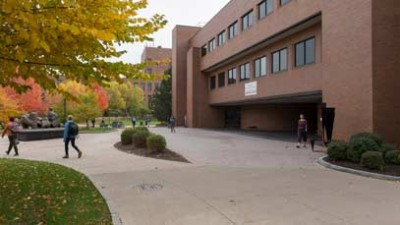SHED and Wallace Library classrooms offer new teaching and learning experience
Scott Hamilton
Classes will fill the SHED complex when the facility opens for the fall semester.
When the Student Hall for Exploration and Development (SHED) opens in the fall, the multi-use facility will create an entirely new learning environment for RIT faculty and students alike.
RIT Professor Matt Marshall combined two sections of the Engineering Exploration seminar that will meet in one of the extra-large classrooms in the SHED. He will teach the entire cohort of undeclared engineering majors in a space large enough for hands-on learning activities.
“We’ve never had the opportunity to teach nearly 150 students in a space conducive to active learning,” said Marshall, associate dean of RIT’s Kate Gleason College of Engineering. “When the SHED came around we knew right away the Engineering Exploration seminar would be a good course to bring into that space and provide that added experiential element to enhance it.”
The seminar is an important course in Marshall’s college and serves nearly 20 percent of incoming engineering majors uncertain which engineering discipline to study. Students in prior years asked for a deeper learning experience to better understand the field. The SHED enables Marshall to rethink the course and offer another way for students to learn about engineering.
The SHED gives Marshall the opportunity to elevate engineering education at RIT by aligning with trends promoted by universities in the national Kern Entrepreneurial Engineering Network (KEEN), which is dedicated to advancing undergraduate engineering education. Marshall is a KEEN leader at RIT.
The large-scale classrooms in the SHED will give instructors like Marshall new teaching tools, such as wireless projection across multiple displays and moveable furniture and white boards for small-group work. For Marshall, the space will accommodate the small-group learning component he is eager to introduce. He will spend the summer designing and tailoring stand-alone activities for his students to complete during a class period.
“Students will come to class, experience the activity, and then take away a greater understanding of what engineers do and how they can bring value to society,” Marshall said.
Learning spaces in the SHED complex will benefit from advances in audio-visual technology networked throughout the five large-scale classrooms in the SHED and the 22 standard-sized rooms in Wallace Library, and the maker space.
Complex AV systems that transmit data via a network will support the large-scale classrooms in the SHED, said Ian Webber, director of academic technologies and operations in the Center for Teaching and Learning. These rooms will be equipped with multiple displays, wireless projection technologies, Zoom compatibility in designated spaces, and sign-language interpretation projected on the display screens.
“The audio-visual network is not something faculty will see, but it will provide them with a new level of flexibility,” Webber said.
The flexible classrooms in Wallace Library are also an important part of the new pedagogical experiences. These rooms will seat 36 to 60 students and include increased square footage per person. The extra elbow room will make a difference, said Sandi Connelly, a member of the SHED classroom team and interim associate director of the Center for Teaching and Learning. Students can easily move the new furniture, designed with wheels, and form groups without being on top of each other or needing to yell to be heard.
Wireless projection will also enhance the Wallace classrooms. The technology will enable students to collaborate and present from anywhere in the room. This helps create a sense of community, noted Juilee Decker, director of the museum studies program in the College of Liberal Arts and the Wehrheim Gallery. Located on the first floor of the SHED, the Wehrheim Gallery will showcase the RIT-Genesee Country Village & Museum Partnership.
“A space like the SHED gives faculty and students the opportunity to flip the script on what they’ve been doing in their class and try something new,” Decker said.
Decker’s Introduction to Museums, a class with 36 students, is scheduled to be held in a Wallace classroom. She will teach many hours of the museum lab component of the class in the SHED complex, where students will use the maker space, visit the Wehrheim Gallery, and explore the RIT Archives and the Cary Graphic Arts Collection in Wallace Library.
“Students will be afforded the opportunity to see our course content prismatically,” Decker said. “They will be able to tap into the history, theories, and concepts from our reading and course discussion and then apply these ideas and their individual learnings as they navigate between the equipment and the materials in the maker space to the books and the special collections in the library to the meeting rooms and activity spaces in the SHED.”
The creative hum in the maker space will spill over into other parts of the SHED, Marshall predicts. His first-year students walking to their Engineering Exploration seminar will pass the student performance teams and clubs working on projects in the maker space located beneath the classrooms. Marshall, who works closely with many of the student clubs, said the synergy will invite students to imagine what they can do at RIT.
“The vicinity offers value,” Marshall said. “Seeing student teams working on exciting projects will be an indirect benefit of having the class in the SHED.”
Teaching in the SHED
The Student Hall for Exploration and Development (SHED) represents a new type of teaching environment for RIT faculty. Resources are available to help faculty adapt their teaching style to the larger spaces or to take advantage of the new features in the many smaller classrooms in Wallace Library.
The Center for Teaching and Learning will offer a Summer Institute May 16-18 and standalone workshops and boot camps throughout the summer that demonstrate teaching methods for large scale-active learning spaces. More information is available at the TeachSHED website.





